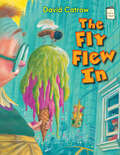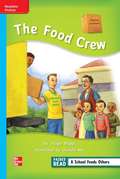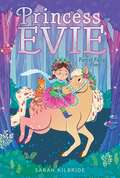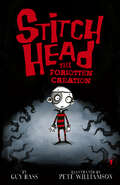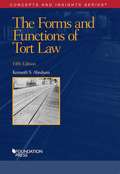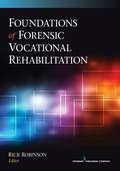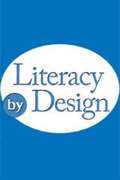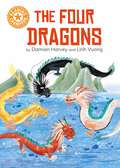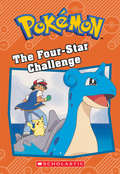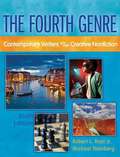- Table View
- List View
The Fly Flew In (I Like to Read)
by David CatrowA fly enters a concert hall and causes a commotion among the audience and performers alike in this funny and easy-to-read picture book. In the wake of a fly's flight, a wig flips, eyeglasses fall, and a lollipop is launched. Musicians BANG and BOOM as they try to get that fly! All fail, and the chaos culminates when an overzealous singer, flyswatter in hand, leaps off the stage. The audience applauds enthusiastically for the greatest display of showmanship they have ever seen. David Catrow pays homage to the slapstick films of the last century with masterfully rendered artwork and an understated text that has a music of its own. An I Like to Read® book, Guided Reading Level C.
The Flying Machine: The Amazing Adventures of Grandpa Ramsbotton (The Amazing Adventures of Grandpa Ramsbotton #1)
by Ron CrouchFollow along as Grandpa Ramsbottom and his grandson Timothy build the ultimate flying machine in Grandpa's magical shed while they plan their adventure to Algonquin Park, Canada. With twists and turns and a little magic, Grandpa and Timothy embark on a trip of a lifetime with far more excitement than they anticipated.
The Flying Squirrel (Fountas & Pinnell Classroom, Guided Reading Grade 2)
by Adam Gustavson Nancy WallaceNIMAC-sourced textbook
The Fools of Chelm (Fountas & Pinnell Classroom, Guided Reading)
by Dina McClellan Leo BrownNIMAC-sourced textbook
The Foraging Spectrum: Diversity in Hunter-gatherer Lifeways
by Robert L. KellyKelly (Anthropology, U. of Wyoming) describes the remarkably complex structures and practices of foraging cultures, such as those in which members store up good will to tide them over the times they cannot hunt or gather. After a solid introduction to the place of foraging societies in anthropology and anthropological theories about environment and evolution from an point of view, Kelly considers a range of aspects of foraging societies, describing studies on mobility, sharing and exchange, land tenure, group size and reproduction, the roles of men and women, egalitarian and non-egalitarian hunter-gatherers, and of the probable systems of foraging in prehistory. Percheron Press is the reprint imprint of Eliot Werner Publications. Annotation ©2007 Book News, Inc., Portland, OR (booknews.com)
The Forest Fairy Pony (Princess Evie #1)
by Sarah KilBridePrincess Evie and her pony go on a magical journey in this first book in an enchanting new chapter book series about a princess, her stable full of ponies, and the amazing adventures they share.Princess Evie is worried about making friends as she joins a new class at school. But her mind is soon put to rest with the help of her magic pony, Willow. Evie and Willow go exploring and find an enchanted forest where they meet a group of forest fairies. Evie makes friends with Arwen, who needs her help rescuing a baby hedgehog. Could their act of kindness lead them to discover a secret fairy treasure?
The Forever Tree (Fountas & Pinnell Classroom, Guided Reading Grade 3)
by Marthe JocelynNIMAC-sourced textbook
The Forgotten Creation (Stitch Head)
by Guy BassEdward Scissorhands meets Miss Peregrine&’s Home for Peculiar Children in this action-packed and not-so-scary chapter book series!A mad professor with a penchant for perfection . . . . The professor&’s monstrous creations, tossed aside and left to fend for themselves in the creepy castle . . . . And Stitch Head—the forgotten one with a heart of gold, who is determined to save them all.Join Stitch Head and an endearing cast of misfits in this humorous, gothic-inspired adventure of friendship, community, and discovering where you truly belong.Soon to be a major motion picture, coming fall 2025!Mad Professor Erasmus created Stitch Head when he was only 10 years old, and the two promised to be friends forever. But when Erasmus grew up, he just wanted to create more and more monsters, each one more grotesque than the last. And Stitch Head was forgotten.Fiercely loyal to his master, Stich Head took on the responsibility of caring for the mad professor&’s creations. When an evil entertainer named Fulbert Freakfinder comes to town and promises to make Stitch Head famous, he is skeptical at first but gradually warms to the idea. Then he learns of Freakfinder&’s true intentions—and is thrown into the adventure of an almost-lifetime! Features black-and-white gothic-inspired artwork. Soon to be a major motion picture, coming fall 2025!The Stitch Head series welcomes readers to Castle Grotteskew, where Mad Professor Erasmus makes creatures out of spare parts and then casts them aside, looking to make bigger and better. Stitch Head, his first creation, has a heart of gold and is always willing to show the other monsters the ropes—and bail them out of trouble! Join Stich Head and the other occupants of the castle in this gothic-inspired series, full of adventures of an almost-lifetime!
The Forms and Functions of Tort Law (Concepts and Insights Series)
by Kenneth AbrahamThe perfect accompaniment to any torts casebook, this text covers all the major cases and issues in a standard torts course. The text addresses cases and analyzes their implications, presenting the law of torts within a curricular context and covering the materials that law students are likely to encounter in a variety of courses. This straightforward, readable text addresses both rules and policy, and presents topics in a way that helps students effectively grapple with issues. Since each chapter stands on its own, the book is ideal as a classroom text, as well as for self-directed reading by students.
The Foundations Of Forensic Vocational Rehabilitation
by Rick RobinsonThis is the first fundamental text to focus specifically on forensic vocational rehabilitation, a field that is forecast to grow rapidly. Forensic vocational rehabilitation consultants evaluate the vocational and rehabilitation needs of individuals in an array of legal settings such as civil litigation, workersí compensation, Social Security disability, and others. The text is unique in its exploration of the vocational rehabilitation process from a biopsychosocial perspective that views disability as a complex and multidimensional construct. The book comprehensively describes the parameters and theoretical issues of relevance in evaluating and developing opinions in forensically oriented matters. It culls and synthesizes current peer-reviewed literature and research on this private subspecialty practice area of rehabilitation counseling, including theories, models, methods, procedures, and fundamental tenets of the field. Also included is current information about the labor market, life care planning, and professional identity, standards, and ethics.
The Four Dragons: Independent reading Orange 6 (Reading Champion #535)
by Damian HarveyThis story is part of Reading Champion, a series carefully linked to book bands to encourage independent reading skills, developed with Dr Sue Bodman and Glen Franklin of UCL Institute of Education (IOE)In this tale from China, four dragons decide to help people when there is a drought by making it rain ... but they didn't get approval from the Emperor and trouble follows.Reading Champion offers independent reading books for children to practise and reinforce their developing reading skills.Fantastic stories are accompanied by engaging artwork and a reading activity. Each book has been carefully graded so that it can be matched to a child's reading ability, encouraging reading for pleasure. This retelling of the original traditional tale is suitable for children aged 5-7, or those reading at book band Orange.
The Four Winds: A Native American Story (Rigby Leveled Library, Level Q #79)
by Sarah Davis Phillip SimpsonNIMAC-sourced textbook
The Four-Star Challenge (Pokémon Chapter Books)
by Howie Dewin Howard DewinThis reissued illustrated chapter book is based on the classic characters found in Pokemon GO and the classic animated series on Netflix.The Orange Islands have a Pokémon League of their own. But these Gym matches are beyond different. Mountain climbing? Dancing Pokémon? And sometimes Ash can't even use his Pokémon! What's up with that? Is Ash up to the challenge? With help from his friends and a little luck, Ash just might have a chance.This reissued illustrated chapter book is based on the classic characters found in Pokemon GO and the classic animated series on Netflix.
The Fourth Genre: Contemporary Writers of/on Creative Nonfiction (Sixth Edition)
by Robert L. Root Michael J. SteinbergThe Fourth Genre offers the most comprehensive, teachable, and current introduction available today to the cutting-edge, evolving genre of creative nonfiction. While acknowledging the literary impulse of nonfiction to be a fourth genre equivalent to poetry, fiction, and drama, this text focuses on subgenres of the nonfiction form, including memoir, nature writing, personal essays, literary journalism, cultural criticism, and travel writing. This anthology was the first to draw on the common ground of the practicing writer and the practical scholar and to make the pedagogical connections between creative writing practice and composition theory, bridging some of the gaps between the teaching of composition, creative writing, and literature in English departments.
The Fox and the Crow
by Mike Litwin Katherine Scraper Lori O'DeaA vain crow loses her snack to a flattering trickster fox.
